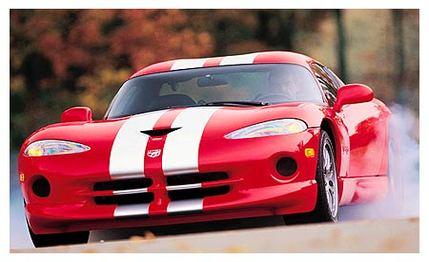 Specialty File
Specialty File
What's this? John Lingenfelter, the founder of Lingenfelter Performance Engineering (LPE), renowned Corvette tuner and builder of the ZR-1 that won Car and Driver's 0-to-150-to-0-mph contest (August 1998), is now modifying Vipers? Isn't this switch a bit like a Mets fan embracing the Yankees?
According to Lingenfelter, plenty of his well-heeled customers aren't as brand-loyal as Chevrolet might wish, and these folks have added Vipers to their fleets. Those double-dipping enthusiasts who already own Lingenfelter-tweaked Vettes wanted the same treatment for their Vipers, and you don't need a Harvard MBA to realize the benefit of granting these customers' wishes.
Last fall, Lingenfelter started offering two Viper engine packages: one for $32,500 that bumps a stock Viper's 488-cubic-inch, 450-hp aluminum V-10 to 510 cubic inches with 670 horsepower; and -- the subject of this test -- a wonderfully indulgent $38,500 package that yields 725 horsepower from 542 cubic inches.
You might think that spending $38,500 for 275 extra horses is downright crazy when one can buy 325 horses and an entire Chevrolet Camaro Z28 SS for less than $27,000 at any Chevy dealership. Such rational price comparisons are out of context, however, when we're talking Vipers, speed, and bragging rights. And if your Viper has Lingenfelter's 542-cubic-inch motor, you can brag loudest of all, since the Lingenfelter Viper is the fastest of the breed that we've ever tested.
On Michelin Pilot Sport street tires, Lingenfelter's beast scampered to 60 mph in only 3.3 seconds and through the quarter-mile in 11 seconds flat at 134 mph. TNT's King Snake Viper ( C/D, May 2000) claimed to have 777 horsepower -- 52 more than this Lingenfelter car -- but required 3.6 seconds to reach 60 mph and passed the quarter-mile in 11.4 seconds at 131 mph. Hennessey Motorsports' Venom 650R ( C/D, July 1999), which was designed for road racing and ran without catalysts and with grippy Hoosier DOT-legal racing rubber, sprinted to 60 mph in 3.4 seconds and through the quarter-mile in 11.4 seconds at 129 mph. (Both the TNT and Lingenfelter cars ran cats.)
This Viper even trounces Lingenfelter's own 415-cid Corvette ZR-1 that swept the 0-to-150-to-0-mph contest. The ZR-1 needed 15.6 seconds to reach 150 mph; this Viper did it more than a second quicker at 14.4 seconds. We could gush on forever, but the simple fact is that the LPE Viper is one of the quickest street-legal cars we've ever tested.
The credit for such prodigious performance goes to three things: good ol' cubic inches, free breathing, and plenty of traction. The traction is due in part to the Viper's rearward weight bias -- 51 percent of its 3400 pounds resides on the rear axle -- and to massive 13-inch-wide rear tires. The rest comes from Lingenfelter's shop in Decatur, Indiana. Once the crew has finished with the Viper motor, all the stock internals are replaced or modified.
The bore is increased from 4.00 inches to 4.03 inches. Stroke goes up from 3.88 inches to 4.25. The billet-steel connecting rods and custom crankshaft are balanced, and new aluminum pistons bump the compression ratio from 9.6:1 to 10.5:1. The heads are CNC-ported for better airflow, and larger valves are fitted with stiffer valve springs and titanium valve-spring retainers. There are also roller rocker arms and a custom camshaft.
The Viper's aluminum intake manifold is sawed apart, hand-ported, and then welded back together. The stock 63mm throttle bodies are swapped for 70mm units with hand-fabricated airboxes. Stainless steel headers and Borla exhaust plumbing expel the spent gases.
With the added displacement and airflow, the engine demands more fuel, and in an odd twist, Lingenfelter has replaced the stock fuel injectors with the same ones used on -- we're not kidding here -- GM's 3.8-liter V-6, which Lingenfelter says matches the fuel requirements.
Piloting a car with roughly the same horsepower as eight Hyundai Accents or five four-cylinder Honda Accords or two Ford SVT Mustang Cobras is, surprisingly, eerily underwhelming. For sure, any prod of the accelerator instantly and forcefully throws you deep into the seat. The acceleration difference between Lingenfelter's Viper and a stock one is readily apparent but also oddly subtle. Even Lingenfelter himself admits that his Viper doesn't feel as fast as it is. The motor observes the same 6000-rpm redline as the stocker, and its 5500-rpm power peak is only 300 higher than the production car's, so the stump-pulling, low-rpm torque (now, with 250 more pound-feet for a total of 740, it's more like house pulling) is still there.
Even hard acceleration runs provide little drama. After a careful launch, quick first-to-second shifts only break the tires loose for an instant, and from that point on, the car is -- as drag racers say -- "hooked up."
For now, Lingenfelter's Viper is top dog, but we doubt that Hennessey, TNT, and other Viper tuners will allow the newcomer to enjoy such prestige for long.
Lingenfelter Performance Engineering, 1557 Winchester Drive, Decatur, Indiana 46733; 219-724-2552; www.lingenfelter.com